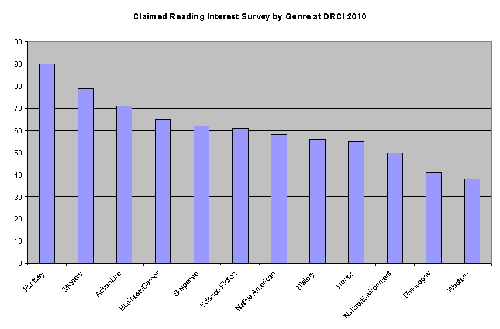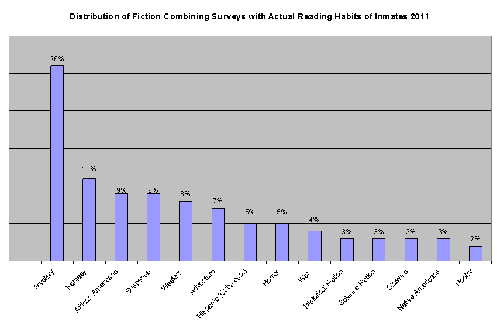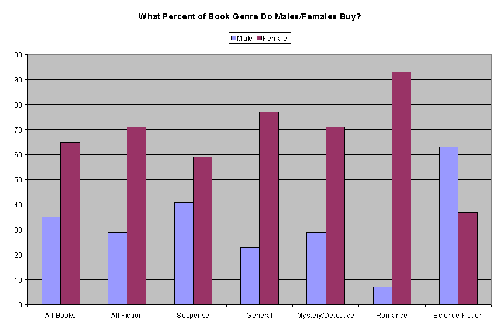|
|
| Part III - The Prison Library: Promoting Reading & Pro-Social Connection |
| By Judith Jordet, MLS |
| Published: 05/02/2011 |
 Reading has a pro-social effect on the reader because the author creates characters to act and react within a social context. When an inmate identifies with a character, he experiences decisions and choices made in a social context and anticipates the consequences for the character. One aspect of criminal thinking is that they often do not sense consequences for their actions because they do not recognize their own social context. This is one reason why I am passionate about promoting reading among inmates. The other reason is to provide an invitation to pro-social bonding with the library.
Reading has a pro-social effect on the reader because the author creates characters to act and react within a social context. When an inmate identifies with a character, he experiences decisions and choices made in a social context and anticipates the consequences for the character. One aspect of criminal thinking is that they often do not sense consequences for their actions because they do not recognize their own social context. This is one reason why I am passionate about promoting reading among inmates. The other reason is to provide an invitation to pro-social bonding with the library.
To begin to promote reading it is helpful to conduct surveys. Surveys are tricky because if you ask people what they want to read, they may say one thing. However if you ask them to list the actual titles they have read, it often leads to a different answer. So I asked both questions. Finding out what they want to read, I asked in the form of an activity/interest questionnaire. Tracking what they actually read, I found out with two reading challenges. First, I sent out an Activity Survey. I conducted the survey between Christmas and New Years when indoor activities would be emphasized. The inmates were to rate how much time they spend on each activity. The survey included indoor activities such as watching television, movies, playing cards, writing letters, doing artwork as well as other activities such as walking, aerobic activity, basketball, free weights, etc. Though all the answers may be helpful for recreation planning, I sandwiched two reading questions in between the list of activities: “How much time do you spend reading books?” and “How much time do you spend reading magazines?” This survey is the baseline of how much time inmates are reading in order to measure any change. Next I sent out an Interest Survey for inmates to choose their favorite 10 genres out of 33 genres and rate each genre from one to ten. Page two of the survey asked inmates to circle what kind of magazines they liked to read from a list of subjects. By combining the results, I got a snap shot of inmate reading habits. For example, I found out inmates would rather read sport magazines than sport books.  Click Here For a Larger Graph I also wanted to know what was actually being read so I conducted two Reading Challenges. The first reading challenge took place during the summer. My state prison was invited to join the local public library in a million page reading competition between two other counties. The Million Page Challenge issued a bookmark with lines on it to write down all the titles read, along with the number of pages. I picked up the bookmarks at the end of each week. I put all the titles read in Excel and identified them by genre. Inmates read 234,849 pages in two months. 258 of the 394 total books were from four categories Mystery, Suspense, Fantasy and Western (our county won). Between Thanksgiving and New Years, I held another “Read Something New” challenge. To encourage inmates to read something other than the four most popular genres, I distributed to each unit a catalog of non-fiction and minority titles available for check out. Horror and Adventure were next highest for fiction and Science and Business were the most popular for non-fiction. As predicted, the reading challenges indicated a preference of fiction over non-fiction. As an example of combining the interest survey with the reading challenges, I was able to surmise an interest in poetry books for minority races over history books on minority groups. After collecting all these statistics, it was time to determine the distribution of genres according to reading interests. Mystery was by far the most enjoyed, so I went looking for a variety of minority authors of mystery (Walter Mosley and Tony Hillerman), written for different reading levels and including both urban/rural settings. At the same time, I kept in mind what adult males in the general public are reading in order to enrich and guide the expansion of my collection for inmates who will one day be free citizens again.  Click Here For a Larger Graph In my last article on demographics I discussed distribution of race and reading level. How would I find out what adult men in the urban centers of my state are reading, compared to rural counties? In Oregon we have a well known bookstore in Portland with a web site listing the 50 most popular books purchased from that store. We also have a large urban county public library with 45 books recommended on their web site based on local reading habits. How can I find out what adult males are reading in rural Oregon? I look at the web sites of rural public libraries. Recently small public libraries and community college libraries have been sponsoring annual community reading projects. This is a program where one book is chosen for all the readers of a rural community to read. National reading trends can be discovered through publisher’s records of yearly book sales. For example, fantasy reading has increased 68% in sales since 1997 (beginning to rival mystery) while horror decreased 30% between 2008 and 2009 [Nielsen BookScan Facts]. Also, even though nationally the largest sub-category of fiction books sold is Romance, that market has identified 90.5% of its readers as females, revealing that less than 10% are males.  Click Here For a Larger Graph Networking with bookstores and libraries in the state can tell you the reading interests of the state. Knowing publisher books sales nationally can help provide ideas on what genres to emphasize. When this effort at collection development by the library is noticed by inmates, it demonstrates an invitation to a pro-social bond. This is one small way to keep inmates connected to the outside culture and to promote reading, through shared reading habits. Link to a sample of national data on reading habits: Click here for Part I. Click here for Part II. Editors Note: Corrections.com author Judith Jordet graduated with Masters of Library Science in 2000; she has worked as a government documents librarian and taught Library Skills at an Oregon Community College. In 2007 Jordet became the full time Library Coordinator in the Oregon Department of Corrections. 70% of her job is as a law librarian. She is also in charge of the general reading collection. Her passion for inmate literacy motivates her to explore ways to promote to the correctional profession, the importance of the prison library for the inmate population to bond with a pro-social experience. She shares the perspective of Stanton Samenow on understanding chronic criminality and Francis Cullen and Mark Colvin on the importance of pro-social support during incarceration. Other articles by Jordet: |
Comments:
Login to let us know what you think
MARKETPLACE search vendors | advanced search

IN CASE YOU MISSED IT
|


Hello to all, today this is the most convenient way for students to get high grades and among the many companies for me is respected one of the paper service where for me always performed essays in the best way.
I have never doubted in reading usefulness. My mother made me read books in childhood when my brother could play and walk all day long. Now I show good performance at college, he does, too but he has problems with essays and have to read about superior papers to order them.
Promoting "Writing" & Pro-Social Connection eBooks-by-Crooks is a for-profit business with a social mission. In the last couple of years we have thought about prisoner ebook publishing and marketing, and how such a project would benefit those serving time in the nation’s prison system. Finally, we decided that we could help, so we decided to create an online vehicle, eBooks-By-Crooks, which allows user-friendly access to inmate writers on all levels of creativity and skills, with full royalties for the writers. For prisoners and ex-prisoners to get published: http://www.ebooks-by-crooks.com/penitentiary-writing-competition.html
This is a wonderful article on a subject I have just recently participated in. Over the past three years I assisted the librarians at a local county jail and later at the state penitentiary. As a certified Truthought Practitioner I was always impressed with how so many inmates took responsibility for the books they checked out of the libraries of the state facility but puzzled at how the library books were so abused at the county level. I would speculate that the tension is higher in a detention center when one's guilt has yet to be adjudicated and is so much higher that destructive behaviors are more manifest. Good job Judy!